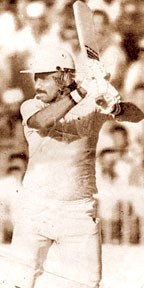Cricket has caught the eye of sporting public
by A.C. de Silva
Cricket is a sport that has a lot of interest for the connoisseur of
the game. There are some instances that will keep the interested parties
glued to the application of the rules to various instances when the
rules have to be applied.
|

Fred Trueman – first bowler to take 300 wickets in Test
cricket. He reached target at The London Oval in his 65th
Test on August 15 in 1964. |
The game of cricket is played according to rules like any other
sport. There are a lot of interesting incidents that take place during a
cricket match.
Any game is played according to a set of rules and for cricket there
are a set of rules and there are the umpires who are deployed to see
that the rules will be adhered to by the two teams that play in the
match.
There are some incidents that are common to the players, but at the
same team there are some incidents that are not familiar with the
players.
'Bail' went 67 yards 6 inches
Take for instance the 'bail' that is kept on the wickets. It is on
record that the longest recorded distance for a bail to travel from
stumps after the batsman has been bowled is 67 yards 6 inches. This
record occurred at Old Trafford, Manchester, on 29th June 1911 when
Robert Burrows of Worcestershire bowled Williams Huddleston of
Lancashire and one of the bails at the batsman's end flew as far as the
boundary.
Cricket is a game where there are many records that are being
established during the course of a game. The cricketers are dead keen in
establishing records so that they will be remembered for many months and
sometimes years to come.
It is on record that the only cricketer to score a century and take
all ten wickets in an innings in a first-class match in Britain since
1869 is Dr. W.G. Grace. He was playing for the MCC against Oxford
University in the Oxford Parks on June 21 and 22 in 1886. "The champion"
scored 104 _ in his only innings, before taking all ten Oxford second
innings wickets for 49 runs in 36.2 four-ball overs.
Six day - fourth Test
|

Javed Miandad – Youngest Test Cricketer to score a double
century – 19 years and 141 days. |
The game is played for long hours and in England there was a match
that was played and finally ended in a draw - that's the Six-Day Fourth
Test between England and Australia at the Oval in 1975. Actual playing
time, excluding 187 minutes lost and 'breaks' between innings, totalled
32 hours 17 minutes.
Two other six-day matches have been staged in England, both Test
matches against Australia at The Oval. In 1930 Australia won at 3.50
p.m. on the last day after rain had prevented play on the penultimate
one. Then 42 years later, Australia repeated their victory at 2.49 p.m.
on the sixth day.
High scores are the fancy of most teams, especially in Test matches.
However, there have been low scores that have caught the eye of
spectators too. The lowest innings total in Test cricket is 26 by New
Zealand at Eden Park, Auckland on 28th March 1955.
Playing the second of Two Tests against Hutton's England team which
had just retained the "Ashes" in Australia, New Zealand had contained
the tourists to a first innings lead of 46. a crowd of 14,000 saw the
home side reduced to 14 for 5 and eventually dismissed in 27 overs by
Frank Tyson (2 for 10), Brian Statham (3 for 9) Appleyard (4 for 7) and
Wardle (1 for 0).
Opening batsman Best sutcliffe (11) achieved the only double - figure
score of an innings which lasted 106 minutes either side of the tea -
interval on the third day.
Appleyard and took 3 wickets in four balls and narrowly missed the
hat-trick. It was Hutton's last.
Don Bradman - 99.94 in Test career
The highest batting average in a Test career involving more than five
innings is 99.94 by Donald Bradman for Australia. In 52 Tests Bradman
scored 6,996 runs from 80 innings, ten of them undefeated. He averaged a
century every 2.8 innings. He needed to score just 4 runs in his final
Test innings on that Saturday 14th of August 1948, in the 5th Test at
the Oval, to become the second (after Hammond) to score 7,000 runs and
the first to attain a career average of 100.
Given a standing ovation by the crowd throughout his progress to the
middle, Bradman was then saluted by three cheers from the England team.
Shortly before Six O' Clock he took guard and safely negotiated the
first ball - a ley-break from Eric Hollies. The next was pitched on a
perfect length - a googly which spun past Bradman's forward defensive
stroke and bowled him.
There is a story that Bradman didn't always go high-up in the batting
order and there was one occasion when he went in at No.7 and it was an
extraordinary performance as he scored 270. Bradman was the established
number 3 batsman for his country.
Hazare - separate hundreds on successive days
Coming to the Indian Pakistan scene - It is on record that the only
batsman to record hundreds on successive days is Vijay Hazare of India
playing against Australia at Adelaide in 1948, Hazare scored 108 on
January 26 and 102 of his second innings and then 145 on January 27.
The youngest to score a double century in Test cricket is Javed
Miandad of Pakistan. He was 19 years 141 days old when he completed his
innings of 206 for Pakistan against New Zealand at Karachi on 31st
October 1976.
It is also a matter of great joy that the fastest hundred in Test
cricket was scored in 70 minutes by Jack Gregory for Australia against
South Africa at Johannesburg on 12th November 1921.
Great bowling feats
The youngest bowler to take 200 wickets in Test cricket is Kapil Dev
of India. He was 24 years and 68 days on 15th March 1983 when he
celebrated his 50th Test by completing the double verses the West Indies
at Port-of-Spain.
Then Fred Trueman - first bowler to take 300 wickets in Test cricket.
He reached the total at The Oval in his 65th Test on 15th August 1964
when he had Neil Hawke of Australia at slip by Colin Cowdrey. |

